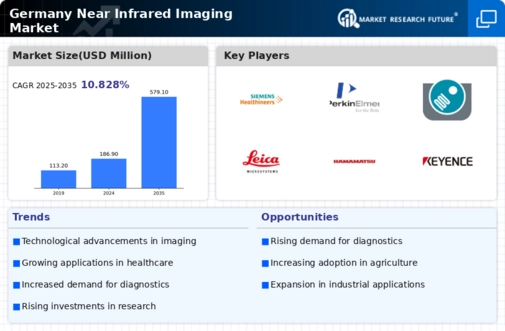Environmental Monitoring and Compliance
Environmental concerns are increasingly influencing the near infrared-imaging market in Germany. The need for effective monitoring of pollutants and compliance with environmental regulations is driving the adoption of imaging technologies. Near infrared-imaging offers a non-invasive method for assessing soil and water quality, making it an essential tool for environmental agencies and industries. With Germany's commitment to sustainability and reducing carbon footprints, the market is expected to grow as organizations invest in technologies that facilitate compliance with environmental standards. Analysts predict a growth rate of around 7% in the near infrared-imaging market, reflecting the rising importance of environmental monitoring.
Rising Focus on Food Safety and Quality
Food safety and quality assurance are paramount concerns in Germany, leading to an increased reliance on near infrared-imaging technologies. This market is particularly influenced by stringent regulations and consumer demand for transparency in food production. Near infrared-imaging enables rapid and accurate analysis of food products, allowing for the detection of contaminants and assessment of quality parameters. The food industry in Germany is expected to invest heavily in these technologies, with estimates suggesting a growth rate of around 8% annually. As the near infrared-imaging market continues to evolve, it is likely to play a pivotal role in ensuring food safety and compliance with regulatory standards.
Advancements in Research and Development
Research and development (R&D) initiatives in Germany are significantly propelling the near infrared-imaging market forward. Academic institutions and private companies are increasingly collaborating to innovate and enhance imaging technologies. This focus on R&D is expected to yield new applications in various fields, including pharmaceuticals and environmental monitoring. The German government has allocated substantial funding for technological advancements, which could lead to breakthroughs in imaging capabilities. As a result, the near infrared-imaging market is anticipated to witness a compound annual growth rate (CAGR) of approximately 10% over the next five years, driven by these advancements.
Integration with Artificial Intelligence
The integration of artificial intelligence (AI) with near infrared-imaging technologies is emerging as a transformative driver in the market. In Germany, AI algorithms are being developed to analyze imaging data more efficiently, enhancing the accuracy and speed of diagnostics in healthcare and industrial applications. This synergy between AI and near infrared-imaging is expected to streamline processes and reduce operational costs. As organizations seek to leverage AI for improved decision-making, the near infrared-imaging market is likely to benefit from increased investments in smart imaging solutions. Projections indicate that the market could expand by 15% as AI adoption becomes more prevalent.
Growing Demand for Non-Destructive Testing
The near infrared-imaging market is experiencing a notable increase in demand for non-destructive testing (NDT) applications across various industries in Germany. This method allows for the evaluation of materials and structures without causing damage, which is particularly valuable in sectors such as manufacturing and construction. The ability to detect flaws and ensure quality control is driving investments in NDT technologies. In 2025, the market for NDT in Germany is projected to reach approximately €1.5 billion, with near infrared-imaging playing a crucial role in enhancing inspection processes. As industries prioritize safety and compliance, the adoption of near infrared-imaging technologies is likely to expand, further solidifying its position in the market.






















Leave a Comment